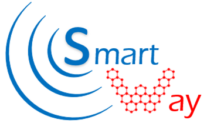SMARTWAY
Nano meta components for electronic smart wireless systems
CONCEPT OF SMARTWAY PROJECT
New communications and radar systems (such as 5G, 6G, and beyond) require small and tunable high-frequency devices, since their backbone is the Internet-of-Things (IoT) that is a wireless network interconnecting tiny objects such as sensors, actuators, and detectors. The need for ultrafast, low-energy-consumption information processing of an exponentially increasing data volume will lead to a global mobile traffic reaching 4394 EB by 2030, thus starting the 6G era of an “ubiquitous virtual existence” when all life activities will be interconnected in real time. Key societal drivers for 6G (data rate up to 1 Tb/s) will be :
- Internet-of-Senses (IoS) (i.e., radar sensors),
- Connected intelligent machines,
- Digitalized and programmable physical world that need to be built on newer technologies delivering non-limiting connectivity, trustworthy systems, and cognitive network.
The next-generation communication technologies (5G: 26–95GHz by 2025 and 6G: 95GHz–3THz by 2030) have stringent requirements and unprecedented needs:
- low bias voltage for beam-steering capabilities;
- increased power efficiency and ultrafast switching times;
- miniaturization for wireless nodes;
- reconfigurability (to implement on-chip antenna multiplexing and antenna tuning);
- frequency scalability (for future increase in bandwidth), among others.
In today’s IoT and IoS applications, radar sensors play one of the major roles. Due to the increased need for higher sensitivity and non-destructive inspection systems, the frequency of the radar sensors has reached up to 300GHz on silicon-based technologies as an early access technology/product. On the other side, 60GHz radar sensing is considered one of the main products for smart home (lighting, automated doors, camera and security, human tracking, gesture sensing), non-destructive material classification, monitoring vital signals (i.e., respiration, heartbeat, or blood pressure), and all the IoT application that need micro-motion detection. The market penetration for these sensors is now hampered by (i) the limited antenna performance (mainly for the 300GHz and above) and (ii) the frequency selectivity and tunability (mainly for the 60GHz case).
Si-based CMOS devices operate close to their theoretical limits in terms of power densities, operating frequencies, and temperature. Furthermore, state-of-the-art sub-THz III-V technologies are prohibitive for ultra-large volume manufacturing needs (50 billion mobile devices by 2030).
The technological breakthrough of SMARTWAY relies on the integration of the following components into the standard high-volume and cost-effective silicon-based technologies to propose radical and innovative solutions: 1) Metamaterials, 2) Two-dimensional material-based antennas, and 3) Carbon nanotube-based filters and switches.
Smartway Objectives:
The originality and innovation of the SMARTWAY project consists in the simultaneous exploitation of advanced nanomaterials (i.e., 2D materials and CNTs) and of the MM concept for the achievement of two main objects corresponding to the realisation of two demonstrators:
1) Objective 1 (Demonstrator 1 ):
design, fabrication, and experimental characterisation of a 300GHz radar chipset with MM-based on-chip or on interposer antennas. Based upon the specifications provided by the industrial partners of the consortium, we will design a T/R module embedding a metal antenna integrated with MMs for gain enhancement at THz frequencies. In this case, the interposer will come from IHP, hence from the NANOPOLY project in which IHP developed the 300GHz bow-tie antenna
2) Objective 2 (Demonstrator 1):
design, fabrication, and experimental characterisation of a 60GHz radar chipset integrating MMs, 2D materials, CNT-based filters, and CNT-based switches for radar communications. Based upon the specifications provided by the industrial partners of the consortium, we will design two versions of a MM-based antenna, i.e., a metal antenna or a 2D material-based antenna (graphene, nanocrystalline graphene etc.). In the case of the metal antenna, the exploitation of the MMs will allow a further miniaturization, an increase of the gain/radiation efficiency/directivity, an enhancement of the bandwidth, or a multi-band functionality. In the case of the 2D antennas, we will match the intrinsic tunability (amplitude of the radiated field and resonance frequency) of the 2D materials with the gain improvement offered by the MMs, thus compensating the medium-low radiation efficiency achievable when using such nanoscale materials.

The Smartway project is funded by HORIZON-EIC-2022-TRANSITION-01 under the grant agreement 101103057
About Smartway
To tackle the problems arisen from the fact that “current digital technologies are gradually reaching the limits of performance and miniaturization while consuming higher and higher amounts of energy”, SMARTWAY proposes novel architectures based on new paradigms that exhibit a significant decrease in energy consumption while improving on speed/performance and miniaturization. The disruptive nature of the targeted approach relies on a progress towards the wafer-scale integration of 2D materials, MMs, and CNTs into radar sensor suitable for IoT sensing applications at both millimeter-waves (i.e., 24–60GHz) and THz frequencies (i.e., 240–300GHz).
CONSORTIUM




